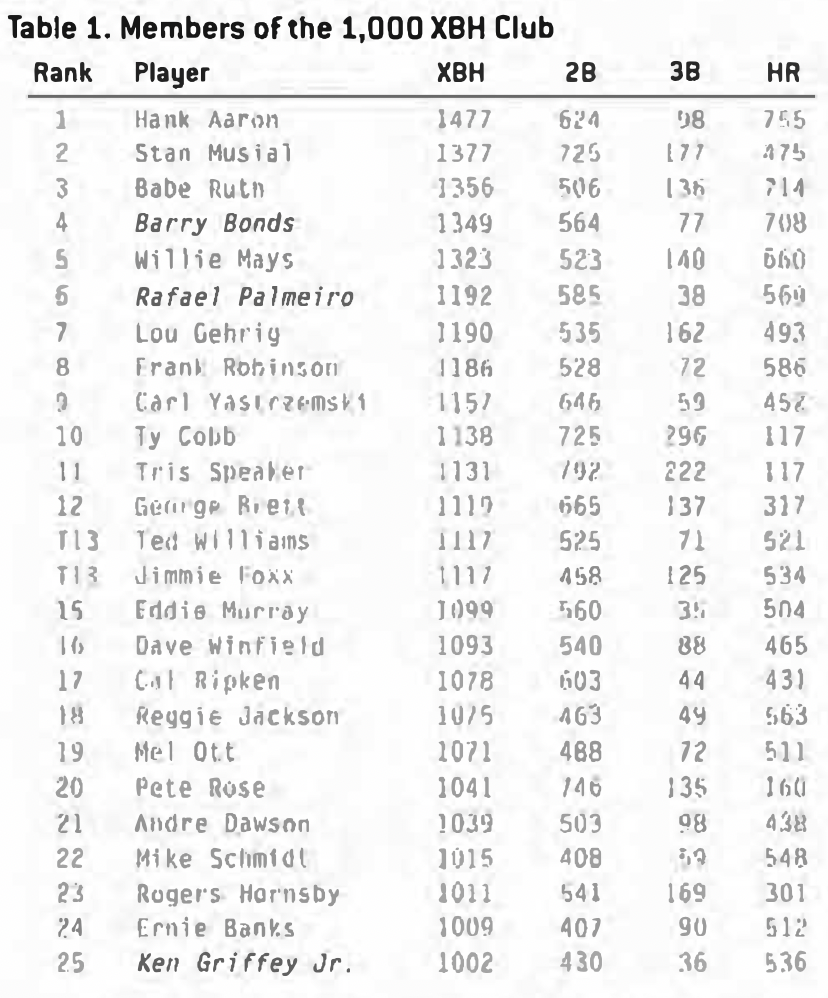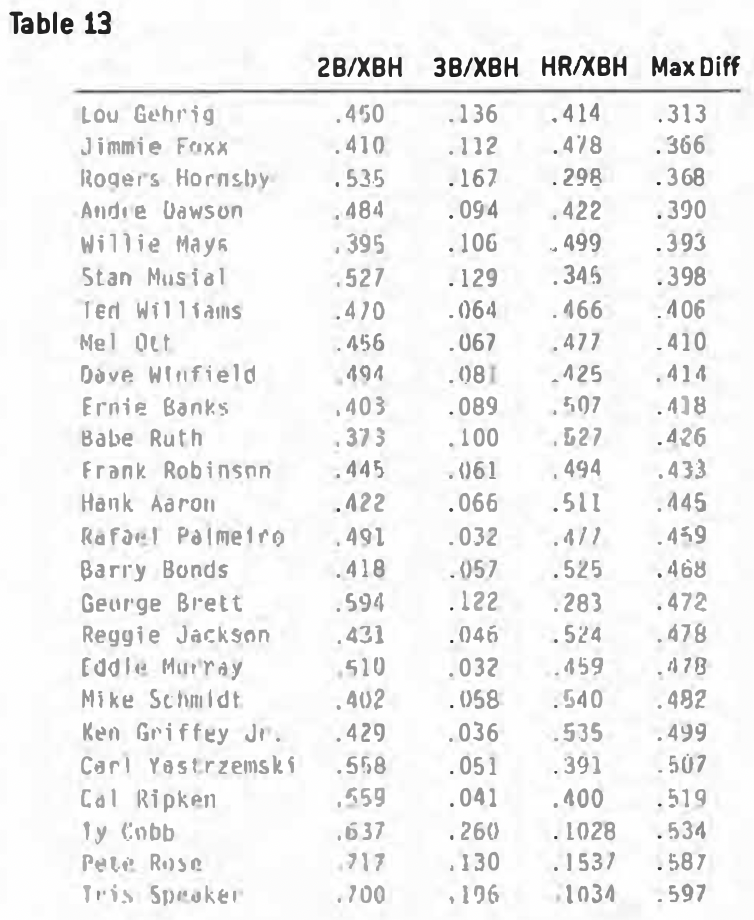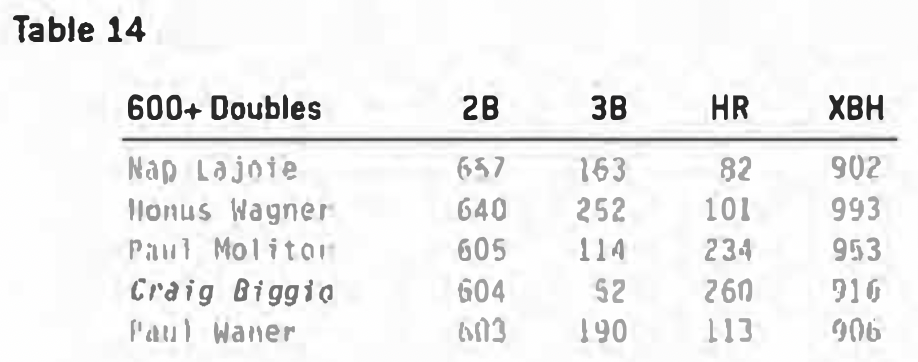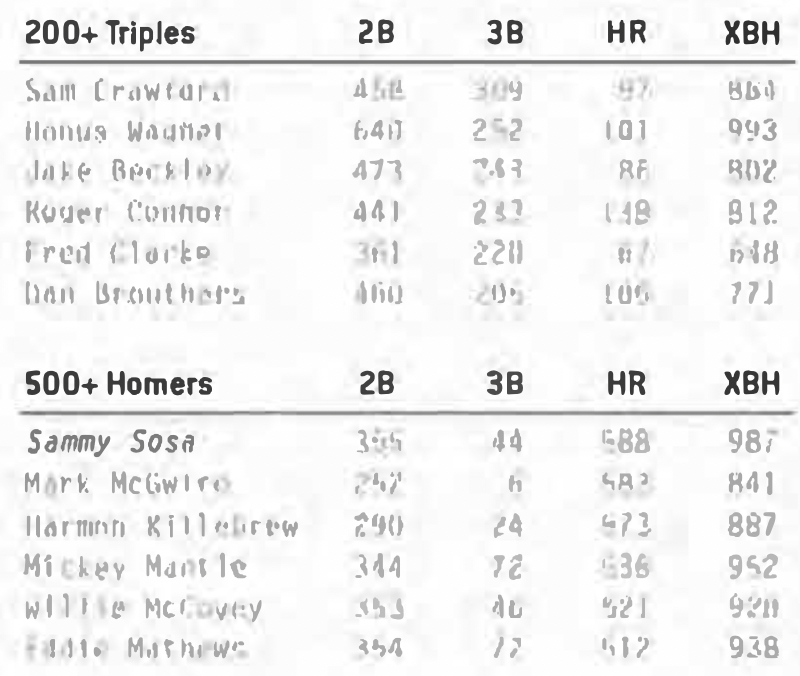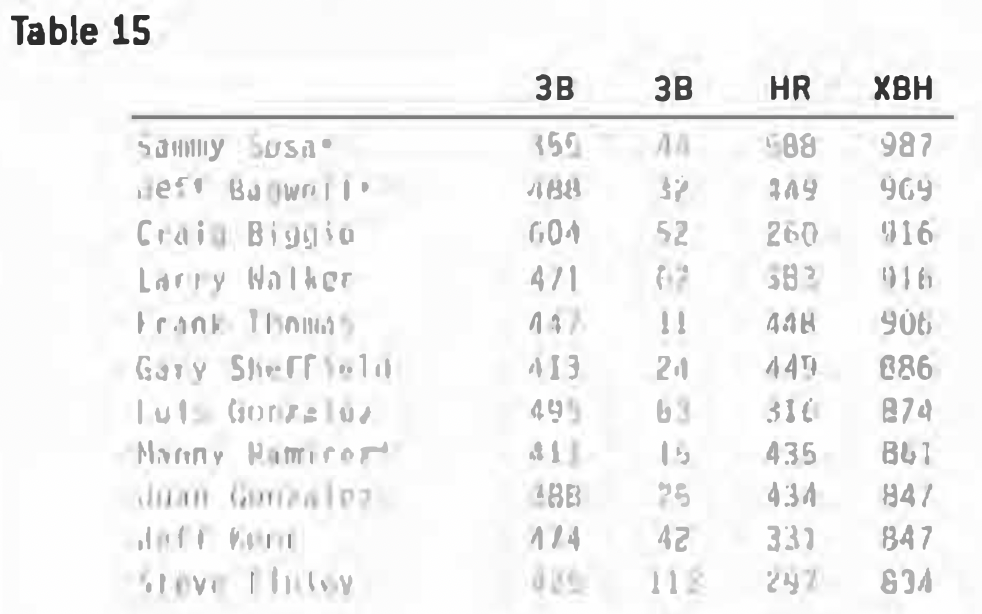1,000 Extra-Base Hits: A Mark of Greatness?
This article was written by Fred Worth
This article was published in 2005 Baseball Research Journal
Many things contribute to playing winning baseball, but one thing is certain. If a team doesn’t score, they don’t win. Extra-base hits drive in runs and we measure sluggers by their extra-base hit performance. For home run hitters, 500 is the magic number. There is no consensus for extra-base hits but I chose to look at players with 1,000 or more extra-base hits.
Ken Griffey Jr.’s sixth-inning double off Kip Wells on August 28, 2005, gave the 1,000 EBH Club its 25th member. Table 1 gives the members of this exclusive club (italics denote player active in 2005).
Note: The sources for the statistics found in this article were
Baseball-reference.com, MLB.com, and Lee Sinin’s Sabermetric Baseball Encyclopedia. There is no consensus on Ty Cobb’s career totals in doubles and triples. His doubles are listed as anything from 723 to 725, his triples from 295 to 297. For the purposes of this paper, I went with Lee Sinin’s numbers.
It seems clear that 1,000 or more extra-base hits is a fairly substantial achievement. Andre Dawson is the only player on the list who is eligible for, but not in, the Hall of Fame. But as with any statistic that only counts something, it can be instructive to look at rates, not just raw numbers. After all, the fact that Richie Hebner hit 203 career home runs to Albert Pujols’ 201 (so far) would not cause many to claim Hebner is the better home run hitter.
It is interesting to note the highest and lowest totals for each kind of hit among these players.
In Table 3, I will look at EBHAvg, the Extra-base Hit Average. This is calculated just as batting average is, EBH/AB.
This view of the data makes a couple of interesting points. First, Babe Ruth is clearly in a class by himself. Also clear is the fact that Pete Rose’s membership in this club is due mostly to the fact that he has nearly 1,700 more at-bats than anyone else in history. Interestingly, looking at this statistic rather than just the number of extra-base hits lends support to those who support Andre Dawson for the Hall of Fame. His EBHAvg is a good bit higher than that of Dave Winfield, Eddie Murray, and Carl Yastrzemski, all of whom were, like Dawson, viewed primarily as slugging run producers.
Another way to look at these data is by percentages of types of hits. In Table 4, we can see 2BAvg (2B/AB) and 2BPct (2B/EBH), with the sorting done by most doubles.
Looking at the data again shows that Rose is on the elite end of the list due mostly to longevity. If we look only at 2BAvg, we see Rose in the middle of the pack.
Looking at 2BPct (Table 6) we see Rose at the top, meaning the large majority of his extra-base hits were doubles. In this regard, he is most like Tris Speaker, but Speaker’s totals were accumulated in substantially fewer at-bats.
(Click images to enlarge)
A couple of observations on these last charts are in order. Babe Ruth is surprisingly high on the list for rate of triples. Even looking at his triples as a percentage of extra-base hits shows Ruth was definitely not a one-dimensional hitter. Also, note that Rose is the only non-Deadball Era player with home runs in fewer than 3% of his at-bats.
In Table 13, we have the players and list their 2BPct, 3Bpct, and HRPct. Additionally, I have listed the difference between their highest and lowest percentage in order to see which players had their extra-base hits most evenly divided.
Lou Gehrig is easily the most balanced of the 1,000 EBH Club. The least balanced are Rose and the 0eadball Era players.
A Few Who Didn’t Make It
Let’s next look at some folks who haven’t joined the club. The following table lists the only players with 600+ doubles, 200+ triples, or 500+ home runs who have not joined the 1,000 EBH Club (bold italics denote players active in 2005).
Honus Wagner is the only player to end up on more than one of these lists. Not surprisingly, most of the players on the doubles and triples lists are from the Deadball Era. Mark McGwire deserves special mention, since more than two.thirds (69.3%) of his extra-base hits are home runs. Pete Rose and Tris Speaker are the only 1,000 EBH Club members with more than two-thirds of their extra-base hits being of any one kind, with each of them with doubles accounting for more than 70%.
Current Players
The following table gives the players who were active in 2005 and have 800 or more extra-base hits.
Several of these players are unlikely to reach the 1,000 EBH Club based on their 2005 performance. While making clear that I make no claims to psychic power, those marked with an asterisk are ones I think will make it.
A few other current players deserve special mention as players who are strong candidates for the 1.000 EBH Club.
Helton and Lou Gehrig are the only players in history with two 100+ extra-base hits seasons. Thome’s chances of 1,000 extra base hits are heavily dependent on his recovery from this season’s injuries. Also, for Helton, Delgado, and Thome, their chances of joining the 1,000 EBH Club are dependent on having at least three more seasons with production similar to what they’ve had their last few full seasons. Their ages may be working against them. Guerrero has had some trouble with injuries. He will have to stay injury-free to make it. Rodriguez and Pujols are as close to guarantees as there are. Barring severe injuries, or pitchers suddenly figuring out consistent ways to get them out, they could threaten Aaron’s leadership.
Conclusion
I think a strong case can be made for 1,000 EBH Club membership being an ironclad Hall of Fame qualification. It requires a long period of consistent production at a high level. Pete Rose, the weakest member of the club, will probably make the Hall of Fame if he is ever reinstated. Rafael Palmeiro may find his path to the Hall obstructed by this year’s steroid scandal. But, considering the number of players Major League Baseball has seen, the number of members of the 1,000 EBH Club, and the strong role extra-base hits play in that all-important consideration of scoring runs, I think it can reasonably be called a mark of greatness.
FRED WORTH is a professor of mathematics at Henderson State University and a lifelong Mets fan who, whenever he plays softball, still wears #24 in honor of his boyhood hero, Willie Mays.



